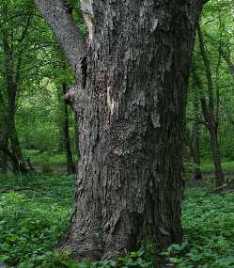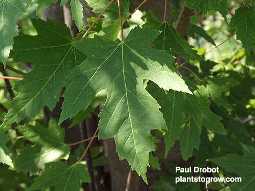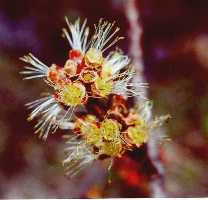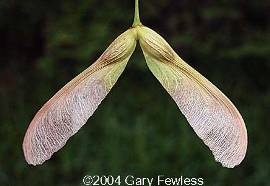Morphology - What is this I am looking at?
 Acer
saccharinum is also known as silver maple. When trying to
identify this silent species their are multiple things to look
at: bark, leaves, flowers, seeds, and roots.
Acer
saccharinum is also known as silver maple. When trying to
identify this silent species their are multiple things to look
at: bark, leaves, flowers, seeds, and roots.
These trees grow to be 50 - 80 feet tall, and an average of 3
feet in diameter. They are fast growing, and have a broad, rounded
crown. The branches bend downward from the trunk before turning
upward at the tips. When the tree is young the bark is gray and
smooth, but as it gets older the bark forms long flakes, and
becomes a darker reddish color.
The most identifiable characteristic is the leaves. They are between 4 and 6 inches long and wide; each leaf has five
sharp lobes, and five veins. The top surface is a light green,
while the underside is a silvery white. When the wind blows, the
silvery underside reveals itself giving Acer saccharinum the
common name of silver maple. In autumn the leaves turn a
yellowish brown in color before falling to the ground for
winter.
between 4 and 6 inches long and wide; each leaf has five
sharp lobes, and five veins. The top surface is a light green,
while the underside is a silvery white. When the wind blows, the
silvery underside reveals itself giving Acer saccharinum the
common name of silver maple. In autumn the leaves turn a
yellowish brown in color before falling to the ground for
winter.
 The
most difficult way to distinguish Acer saccharinum from its closest
relative, Acer rubrum, is the flowers. Both Acer rubrum
and Acer saccharinum have bright
red flowers. The flowers are small, and appear on short stalks
of the tree. Though at times Acer
saccharinums' flowers look more greenish
the largest difference in flowers is the
blooming period. Over a week before the
Acer rubrum blooms, Acer saccharinums'
flowers open, thusly the Acer saccharinum
is the earliest blooming maple.
The
most difficult way to distinguish Acer saccharinum from its closest
relative, Acer rubrum, is the flowers. Both Acer rubrum
and Acer saccharinum have bright
red flowers. The flowers are small, and appear on short stalks
of the tree. Though at times Acer
saccharinums' flowers look more greenish
the largest difference in flowers is the
blooming period. Over a week before the
Acer rubrum blooms, Acer saccharinums'
flowers open, thusly the Acer saccharinum
is the earliest blooming maple.
 The fruit of Acer saccharinum
is the largest fruit created by a native United
States maple. Each pollinated flower of the tree
creates a fruit. These fruit look like a
helicopter by connecting two wings, each called
a key, that are 90 degrees apart. Each key is
between 40 and 70 millimeters long. Only one of
the two wings develops a seed in their ribbed seedcase. By
late spring the seeds are mature; this is close to the same time
that the leaves become fully mature. At this time each key is
let off individually.
The fruit of Acer saccharinum
is the largest fruit created by a native United
States maple. Each pollinated flower of the tree
creates a fruit. These fruit look like a
helicopter by connecting two wings, each called
a key, that are 90 degrees apart. Each key is
between 40 and 70 millimeters long. Only one of
the two wings develops a seed in their ribbed seedcase. By
late spring the seeds are mature; this is close to the same time
that the leaves become fully mature. At this time each key is
let off individually.
The last morphological characteristic is the
root system. Unlike many trees there is not a single taproot. Because of their
habitat, Acer saccharinum has a very shallow, hair-like,
root system.
Learn about the classification
of this species.